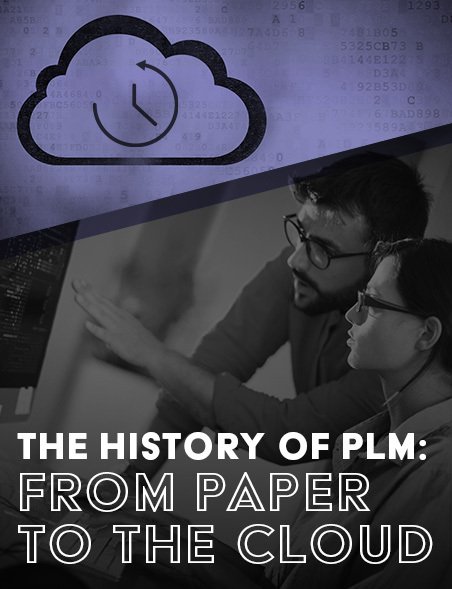6 Tips for a Smoother Product Lifecycle Management (PLM) Software Implementation

Companies are run on people, processes and tools. Adding new tools into the mix means a change in the way people work and the way the business is run. Taking a step-by-step approach and getting buy-in from all stakeholders when putting a new tool in place will help ensure a smooth, successful implementation. Implementing product lifecycle management (PLM) is no different. This article provides six tips for manufacturers that are considering using a PLM software system or are ready to begin a PLM implementation.
Product lifecycle management defined
Product lifecycle management (PLM) can be described as the people, processes, and tools used to manage a product and the product record from concept through design, development, and production. Organizations implement product lifecycle management to achieve a number of business goals like faster time to market and lower scrap and rework costs. While many PLM solutions are available in the market today, most organizations are already doing some parts of product lifecycle management without a specialized system.
What kind of system do you have?
Some organizations use spreadsheets for bill of materials (BOM) management, paper-based processes for engineering change orders (ECOs) management, or CAD and product data management (PDM) systems for managing 2D and 3D models. PLM solutions were designed to manage all of these processes and others to streamline new product development (NPD) and speed the design and delivery of products to market.
Other companies may consider more specialized systems to help streamline what’s currently being done today, especially if the current process isn’t working. For example, if tens or hundreds of cross-referenced spreadsheets have become too cumbersome to manage, a BOM management software solution may be the answer.
Implementing PLM
Just like implementing any other tool, taking a methodical approach to getting departmental and executive approval will help you make the best solution choice and ultimately ensure a smooth and successful implementation. Here are six tips to use when implementing a PLM strategy:
Six tips for a smooth, successful PLM implementation
- Tip #1: Establish objectives & goals for your PLM strategy
- Tip #2: Review your processes
- Tip #3: Review your data
- Tip #4: Obtain organizational & executive buy-in
- Tip #5: Work from a project plan & assign a project lead
- Tip #6: Train people on the new processes early
Tip #1: Establish objectives and goals for your PLM strategy
If you’re seeking a product lifecycle management solution or thinking of implementing an aspect of PLM, start by defining your reasons for taking such a step. Some common operational goals and objectives include:
- Centralizing product data for better accessibility
- Standardizing bills of materials and removing duplicate content
- Moving from a paper-based to an electronic ECO process
- Connecting product data to another system (like ERP software)
- Managing regulatory requirements
This will give you a clear picture of which processes need to be more formalized now and which ones can wait until some point in the future. That understanding will help you define your PLM needs and plan gradual upgrades and improvements that are less likely to disrupt the work environment. Establishing clear objectives and goals will also enable you to measure the success of the PLM implementation process — and the success of your new PLM processes and/or systems.
Tip #2: Review your processes
Review current processes to determine if or how they should be mapped to a PLM system. For example, if your engineering change order (ECO) management process is paper-based, how will a PLM software system that allows approvers to review ECOs in parallel change this process?
Take the time to review what you’re doing now and think about how it could be different with a new system in place. Who are the people inside and outside the organization who be impacted by changes to your processes? How will they be affected?
Knowing what gets done, who does it, and who is impacted is an important part of the PLM implementation process, both in the planning stage and the buy-in stage (see Tip #4). Reviewing processes ahead of time will set you up for a faster, smoother implementation—and it may give you ideas for how to streamline processes even if you don’t implement a more formal system.
Tip #3: Review your data
Moving into a new house typically means spending time going through household items and deciding what needs to be packed in the moving truck and what doesn’t. Similarly, if you’re going to make a change to where data “lives,” you need to do some housecleaning before the move. If existing BOMs and data are managed in Excel spreadsheets, spend time reviewing these files and decide what data needs to be moved and what data can stay where it is. Make sure any information being moved is accurate and in tip-top shape. (Here are 10 ways to get your Excel BOMs ready for a fresh start.) When you take the time to review and clean your BOMs, you’ll know you can trust the data that gets moved into a new PLM software system.
Tip #4: Obtain executive & organizational buy-in
Process change can be hard but successfully implementing a PLM system can bring financial benefits to the organization while also improving the day-to-day experience of the team. For your product lifecycle management strategy to work, you must get the executive team and those in the organization who will use the new system to agree with your objectives and your plan.
The executive team can provide incentives and motivation to keep the implementation from going askew. Those who will be using the PLM system (as identified in the second tip above) need to be educated on how it’s going to make their jobs easier. If the users can contribute to the PLM project and help reshape the processes in which they participate, they will become emotionally involved and more likely to see the value.
Tip #5: Work from a project plan and assign a project lead
When implementing PLM, it’s best to work from a project plan and assign a project lead from your organization. Having a list of milestones with deadlines clearly delineated will help the implementation process move along more efficiently. In addition, areas that need help will be more easily identified.
To answer any questions that arise during the PLM implementation, have a designated point person from your organization and from the PLM vendor. With a well-structured plan and a project lead who has the support of the executive team, your organization can stay on track for a successful PLM implementation.
Tip #6: Train people on the new processes early
Many PLM systems today are easy to use and most have online help systems with product documentation to answer immediate questions. Web training and classes may also be available to help users achieve individual success with the PLM software system.
If users are forced to use a system they have never seen before, they are likely to stick with the old way until forced to switch—and even then may make the switch with great reluctance. Getting users access to training material early in the PLM implementation process will help maintain momentum and contribute to a more efficient outcome with better control of processes and data.
Implementing PLM can be done smoothly and successfully
Successfully implementing a PLM system helps prepare your organization for growth. Whether you need to bring on new people or expand your product line, you will have the infrastructure in place to train new employees quickly and make sure the entire organization is following the same established processes.
When you take a step-by-step approach and obtain executive and organizational buy-in, a PLM implementation can be done easily and effectively. Following the six tips above will help streamline your product development processes and give you confidence that you’re working with clean and validated data. Many of the tips can also be used to help you better understand and improve the processes you’re using today.




